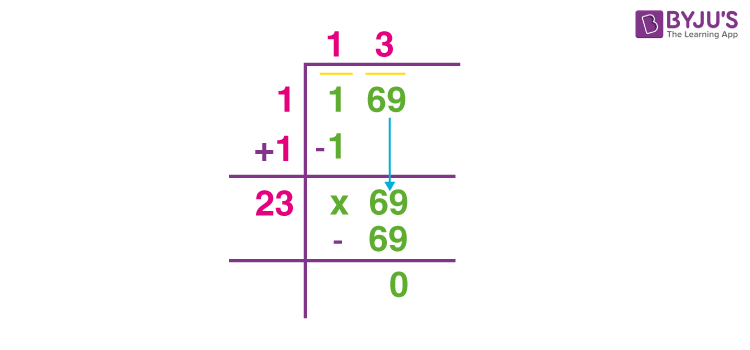In mathematics, the square root of a number is a value that gives the original number on multiplication by itself. If p is the square root of q, then it is represented as p = √q, or we can express the same equation as p2 = q. Here,’√’ is the radical symbol used to denote the root of numbers. The positive number, when multiplied by itself, represents the square of the number. Thus, the square root of the square of a positive number gives the original number. In this article, you will learn how to calculate the square root of 169 in different methods and the solved examples on the square root of 169.
What is the Square root of 169?
The square root of 169 is 13, i.e. √169 = 13. The radical representation of the square root of 169 is √169. Also, we know that the square of 13 is 169, i.e. 132 = 13 × 13 = 169. Thus, the square root of 169 can also be expressed as, √169 = √(13)2 = √(13 × 13) = 13. Also, we can say that 169 is a perfect square. However, the square root of 169 is ±13. As we know, 13 × 13 = 169 and (-13) × (-13) = 169. From this representation, we can say that the square root of 169 can be both positive and negative of 13. In general, “the square root” is often used to refer to the principal or non-negative square root. Hence, we write the positive number as the result unless it is specified as roots.
| Read more: |
How to Calculate Square root of 169
We can calculate the square of 169 in different ways such as the subtraction method, prime factorization and long division method. All these methods are explained here with detailed explanations.
Square root of 169 by Repeated Subtraction Method
In this method, we should subtract the successive odd numbers till we obtain zero, starting from 169 and 1. The number of odd numbers we subtract in this process is treated as the square root of 169.
- 169 – 1 = 168
- 168 – 3 = 165
- 165 – 5 = 160
- 160 – 7 = 153
- 153 – 9 = 144
- 144 – 11 = 133
- 133 – 13 = 120
- 120 – 15 = 105
- 105 – 17 = 88
- 88 – 19 = 69
- 69 – 21 = 48
- 48 – 23 = 25
- 25 – 25 = 0
Thus, starting from 169, we have subtracted 13 times to obtain 0. Therefore, the square root of 169 is 13.
Click here to get more information about the square root of a number by repeated subtraction method.
Square root of 169 by Prime factorization
In the prime factorization method, we have to divide the number by prime numbers starting from 2. When it cannot be divided further with 2, divide it with the next prime number, i.e. 3 and continue this process till we get 1.
169 ÷ 2 = 84.5
169 ÷ 3 = 56.33
169 ÷ 5 = 33.8
169 ÷ 7 = 24.1428
169 ÷ 11 = 15.3636
169 ÷ 13 = 13
Here, 13 is the prime number and is one of the prime factors of 169.
So, 13 ÷ 13 = 1
Therefore, the prime factorization of 169 is 13 × 13.
That means, 169 = 13 × 13
Now, take the square root on both sides of the above representation.
√169 = √(13 × 13) = 13.
Hence, the square root of 169 is equal to 13.
Square root of 169 by Long division method
Go through the procedure given below, to learn how to find the square root of 169 by the long division method.
- Write 169.
- Take the digits of the number in pairs from the right. So, from 169, 69 is chosen as a pair, and 1 stands alone.
- We need to divide 1 with a number such that the number × number gives 1 or a number less than that.
- Now, we got 1 as the quotient and 0 as the remainder.
- Let’s bring down 69 for division.
- Double the divisor, that means 1 + 1 = 2. Write this as one of the digits for the new divisor.
- Find a number that can be placed next right of 2 to obtain a two-digit number as a new divisor. Also, the number set here should be multiplied by itself to produce 69 or fewer than that.
- We find that 3 is the number such that 23 × 3 gives 69.
- Now we got the quotient 13, and the remainder as 0.

Get Square Root of More Numbers Here
Video Lessons on Square Roots
Visualising square roots

Finding Square roots

Solved Examples
Example 1:
The area of a square is 169 square units. Find the length of the side of that square.
Solution:
Given,
Area of a square = 169 square units
We know that the area of a square of side “a” = a2
So, a2 = 169
a = √169 = 13 {a cannot be -13 since the side measure cannot be negative}
Therefore, the side of the square is 13 units.
Example 2:
Simplify: 14 + √169 – 7 × 3.
Solution:
14 + √169 – 7 × 3
= 14 + 13 – 7 × 3
= 14 + 13 – 21
= 27 – 21
= 6
Therefore, 14 + √169 – 7 × 3 = 6.
If we take √169 = -13, then:
14 + √169 – 7 × 3
= 14 – 13 – 7 × 3
= 14 – 13 – 21
= -20
Frequently Asked Questions on Square root of 169 – FAQs
How do you find the square root of 169?
We can find the square root of 169 in three different ways, namely repeated subtraction, prime factorisation and long division method.
What squared gives you 169?
Squaring 13 gives us the result 169, since the square root of 169 is 13. Hence, the square of 13 will be 169. That means, 13^2 = 13 × 13 = 169.
Is the cube root of 169 rational or irrational?
The cube root of 169 is irrational since it is not a perfect cube number.
Is 169 a perfect square?
Yes, 169 is a perfect square since the square root of 169 is 13, which is a whole number.
Is the square root of 169 a rational number?
Yes, the square root of 169 is a rational number. As we know that √169 = 13, a rational number.

Comments